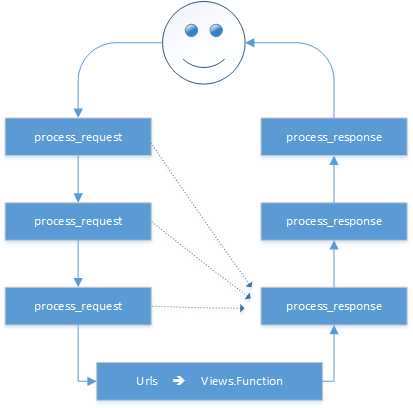标签:问题 大致 .com 登录验证 render match 方便 bsp shortcut
Django的request请求需要首先经过中间件处理,再通过URL查找到对应的views函数进行处理。在settings的MIDDLEWARE_CLASSES中添加设置中间件进行激活,大致原理如下图所示:

在使用Django框架进行开发的过程中,遇到一个问题:要求对觉得多数页面请求request进行用户登录验证,如果用户没有登录则跳转回到登录页面;如果用户登录了,则直接跳转到新的链接页面?
在django中提供了一种自定义装饰器@login_required来实现验证用户登录:
1 # coding: utf-8 2 from django.shortcuts import render 3 from django.contrib.auth.decorators import login_required 4 5 @login_required 6 def home(request): 7 return render(request, ‘home.html‘)
但是这种方式有一个不方便的地方:如果每添加一个功能需要验证登录,就需要添加@login_required来进行装饰。如果有大量的功能需要进行登录验证,工作量会增大。或者如果因为需求变化,删除装饰器,这种工作量会比较麻烦。
所以在学习过程中,想到使用django的中间件来进行登录验证,在settings中增加参数,排除不需要登录的url,如:
EXCLUDE_URL = (
‘/login/‘,
‘/logout‘,
)
然后再创建一个中间件模块,将此中间件添加到MIDDLEWARE_CLASSES中,定义process_request函数,对登录的url进行验证:
# coding: utf-8
from djangoMiddleware.settings import EXCLUDE_URL
from django.shortcuts import HttpResponseRedirect
import re
exclued_path = [re.compile(item) for item in EXCLUDE_URL]
class PubAuthMiddleWare:
def process_request(self, request):
url_path = request.path
for each in exclued_path:
if re.match(each, url_path):
return
if request.user.is_authenticated:
return HttpResponseRedirect(‘/logout‘)
else:
return
其中的exclude_path为不需要验证登录的url,直接return进入响应的views.fun进行处理。
Django的中间件是很方便的,当需要对所有的request进行相同的处理时,可以使用中间件进行处理,很方便。
标签:问题 大致 .com 登录验证 render match 方便 bsp shortcut
原文地址:http://www.cnblogs.com/trs21/p/6792933.html